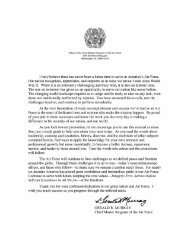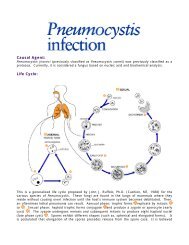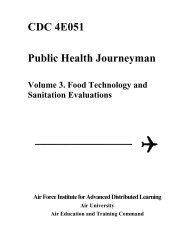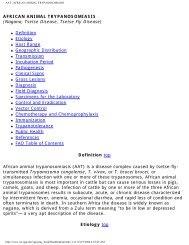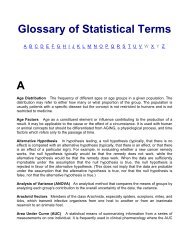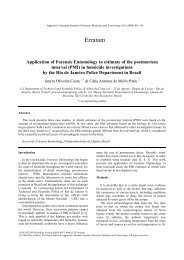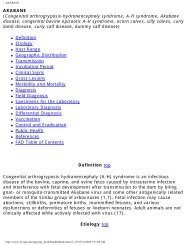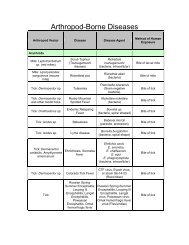DOURINE (Slapsiekte, el Dourin, Mal de Coit, Beschalseuche ...
DOURINE (Slapsiekte, el Dourin, Mal de Coit, Beschalseuche ...
DOURINE (Slapsiekte, el Dourin, Mal de Coit, Beschalseuche ...
Create successful ePaper yourself
Turn your PDF publications into a flip-book with our unique Google optimized e-Paper software.
<strong>DOURINE</strong><br />
<strong>DOURINE</strong><br />
(<strong>Slapsiekte</strong>, <strong>el</strong> <strong>Dourin</strong>, <strong>Mal</strong> <strong>de</strong> <strong>Coit</strong>, <strong>Beschalseuche</strong>, Covering Disease)<br />
●<br />
●<br />
●<br />
●<br />
●<br />
●<br />
●<br />
●<br />
●<br />
●<br />
●<br />
●<br />
●<br />
●<br />
●<br />
●<br />
●<br />
●<br />
●<br />
●<br />
Definition<br />
Etiology<br />
Host Range<br />
Geographic Distribution<br />
Transmission<br />
Incubation Period<br />
Clinical Signs<br />
Gross Lesions<br />
Mortality<br />
Diagnosis<br />
Fi<strong>el</strong>d Diagnosis<br />
Specimens for the Laboratory<br />
Laboratory Diagnosis<br />
Differential Diagnosis<br />
Treatment<br />
Vaccination<br />
Control and Eradication<br />
Public Health<br />
References<br />
FAD Table of Contents<br />
Definition top<br />
<strong>Dourin</strong>e is a chronic trypanosomal disease of Equidae. The disease is transmitted<br />
almost exclusiv<strong>el</strong>y by coitus and is characterized by e<strong>de</strong>matous lesions of the<br />
genitalia, nervous system involvement, and progressive emaciation.<br />
Etiology top<br />
<strong>Dourin</strong>e is caused by Trypanosoma equiperdum (Fig. 48) (Doflein, 1901), a<br />
protozoan parasite r<strong>el</strong>ated morphologically and serologically to T. brucei, T.<br />
rho<strong>de</strong>siense, and T. gambiense (of the subgenus Trypanozoon of the Salivarian<br />
section of organisms of the pathogenic genus Trypanosoma). Different strains of<br />
the parasite vary in pathogenicity (5).<br />
http://www.vet.uga.edu/vpp/gray_book/Handh<strong>el</strong>d/dou.htm (1 of 7)3/5/2004 4:13:35 AM
<strong>DOURINE</strong><br />
Host Range top<br />
<strong>Dourin</strong>e is typically a disease of horses and donkeys. Positive CF tests have been<br />
obtained from zebras, although it has not been shown that zebras can be infected<br />
with T. equiperdum or transmit the disease. The organism has been adapted to a<br />
variety of laboratory animals (5,6,9).<br />
Improved breeds of horses seem to be more susceptible to the disease. The<br />
disease in these animals often progresses rapidly and involves the nervous<br />
system. In contrast, native ponies and donkeys often exhibit only mild signs of the<br />
disease. Infected male donkeys, which may be asymptomatic, are particularly<br />
dangerous in the epi<strong>de</strong>miology of the disease, for they may escape <strong>de</strong>tection as<br />
carriers.<br />
Geographic Distribution top<br />
Once wi<strong>de</strong>spread, this disease has been eradicated from many countries. It is<br />
currently present in most of Asia, southeastern Europe, South America, and in<br />
northern and southern Africa (3)<br />
Transmission top<br />
This venereal disease is spread almost exclusiv<strong>el</strong>y by coitus. Organisms are<br />
present in the urethra of infected stallions and in vaginal discharges of infected<br />
mares. The organism may pass through intact mucous membranes to infect the<br />
new host. Infected animals do not transmit the infection with every sexual<br />
encounter, however. As the disease progresses, trypanosomes periodically<br />
disappear from the urethra or vagina; during these periods, the animals are<br />
noninfective. Noninfective periods may last for weeks or months and are more<br />
lik<strong>el</strong>y to occur in the later stages of the disease. Thus, transmission is most lik<strong>el</strong>y<br />
early in the disease process.<br />
It is possible for mares to become infected and pregnant after mating with an<br />
infected stallion. Foals born to infected mares may be infected. It is unclear if this<br />
occurs in utero or during birth. Because trypanosomes may occur in the milk of<br />
infected mares, these foals may be infected per os during birth or by ingestion of<br />
infected milk. Foals infected in this way may transmit the disease when mature<br />
and <strong>de</strong>v<strong>el</strong>op a lif<strong>el</strong>ong positive CF titer. This method of disease transmission is<br />
rare, however. Some foals may acquire passive immunity from colostrum of<br />
infected mares without becoming activ<strong>el</strong>y infected; in such foals, the CF titer<br />
<strong>de</strong>clines, and the animal becomes seronegative by 4 to 7 months of age. Although<br />
the possibility of noncoital transmission remains uncertain, it is supported by<br />
http://www.vet.uga.edu/vpp/gray_book/Handh<strong>el</strong>d/dou.htm (2 of 7)3/5/2004 4:13:35 AM
<strong>DOURINE</strong><br />
sporadic infections in sexually immature equids (1,3,5).<br />
Incubation Period top<br />
The incubation period is highly variable. Clinical signs usually appear within a few<br />
weeks of infection but may not be evi<strong>de</strong>nt until after several years (1,5,7).<br />
Clinical Signs top<br />
Clinical signs vary consi<strong>de</strong>rably, <strong>de</strong>pending on the virulence of the infecting strain,<br />
the nutritional status of the infected animal, and the presence of other stress<br />
factors. The strain prevalent in southern Africa (and formerly in the Americas) is<br />
apparently less virulent than the European, Asian, or north African strains and<br />
produces an insidious, chronic disease. In some animals, clinical signs may not be<br />
apparent for up to several years (so-called latent infection). Clinical signs may be<br />
precipitated by stress in these animals.<br />
In mares, the first sign of infection is usually a small amount of vaginal discharge,<br />
which may remain on the tail and hindquarters. Sw<strong>el</strong>ling and e<strong>de</strong>ma of the vulva<br />
<strong>de</strong>v<strong>el</strong>op later and extend along the perineum to the ud<strong>de</strong>r and ventral abdomen.<br />
There may be vulvitis and vaginitis with polyuria and other signs of discomfort<br />
such as an <strong>el</strong>evated tail. Abortion is not a feature of infection with mild strains, but<br />
significant abortion losses may accompany infection with a more virulent strain.<br />
In stallions, the initial signs are variable e<strong>de</strong>ma of the prepuce and glans penis<br />
(Fig. 49), spreading to the scrotum and perineum and to the ventral abdomen and<br />
thorax. Paraphimosis may be observed. The sw<strong>el</strong>ling may resolve and reappear<br />
periodically. Vesicles or ulcers on the genitalia may heal and leave permanent<br />
white scars (leuko<strong>de</strong>rmic patches). Transient cutaneous plaques are a feature of<br />
the disease in some locations and strains but not others. When they occur, they<br />
are pathognomonic. Conjunctivitis and keratitis are often observed in outbreaks of<br />
dourine and may be the first signs noted in some infected herds.<br />
Nervous disor<strong>de</strong>rs may be seen soon after the genital e<strong>de</strong>ma or may follow by<br />
weeks or months. Initially these signs consist of restlessness and the ten<strong>de</strong>ncy to<br />
shift weight from one leg to another followed by progressive weakness and<br />
incoordination and ultimat<strong>el</strong>y by paralysis and recumbency. Anemia and<br />
emaciation sometimes accompany <strong>de</strong>v<strong>el</strong>opment of clinical signs even though the<br />
appetite remains unaffected.<br />
<strong>Dourin</strong>e is characterized by stages of exacerbation, tolerance, or r<strong>el</strong>apse that may<br />
vary in duration and occur several times before <strong>de</strong>ath or recovery. The course of<br />
http://www.vet.uga.edu/vpp/gray_book/Handh<strong>el</strong>d/dou.htm (3 of 7)3/5/2004 4:13:35 AM
<strong>DOURINE</strong><br />
the disease may last several years after infection with a mild strain.<br />
Experimentally, horses have survived for up to 10 years after infection. The course<br />
is apparently more acute in the European and Asian forms of the disease in which<br />
the mortality rate is higher (1,5).<br />
Gross Lesions top<br />
Anemia and cachexia are consistent findings in animals that have succumbed to<br />
dourine. E<strong>de</strong>ma of the genitalia and ventral abdomen become indurated later in<br />
the course of the disease. Chronic lympha<strong>de</strong>nitis of most lymph no<strong>de</strong>s may be<br />
evi<strong>de</strong>nt. Perineural connective tissue becomes infiltrated with e<strong>de</strong>matous fluid in<br />
animals with nervous signs, and a serous infiltrate may surround the spinal cord,<br />
especially in the lumbar or sacral regions (1,5,7).<br />
Mortality top<br />
Although the course of the disease may be long, it is usually fatal. Uncomplicated<br />
dourine does not appear to be fatal unless the nervous system is involved. The<br />
progressive <strong>de</strong>bilitation associated with the neurological manifestation of the<br />
disease predisposes infected animals to a variety of other conditions. Because of<br />
the long survival time in some experimental cases, reports of recovery from<br />
dourine should be regar<strong>de</strong>d with skepticism.<br />
Diagnosis top<br />
Fi<strong>el</strong>d Diagnosis top<br />
Diagnosis on physical signs is unr<strong>el</strong>iable because many animals <strong>de</strong>v<strong>el</strong>op no sign.<br />
When signs are present, however, they are suggestive of a diagnosis of dourine. If<br />
"silver dollar plaques" occur, they are pathognomonic for dourine.<br />
Specimens for the Laboratory top<br />
Detection of trypanosomes is highly variable and is not a r<strong>el</strong>iable means for<br />
diagnosis of dourine. The following specimens should be submitted: serum, whole<br />
blood in EDTA, and blood smears.<br />
Laboratory Diagnosis top<br />
A r<strong>el</strong>iable complement-fixation test (CFT) has been the basis for the successful<br />
eradication of dourine from many parts of the world. The antigen used in the CFT<br />
http://www.vet.uga.edu/vpp/gray_book/Handh<strong>el</strong>d/dou.htm (4 of 7)3/5/2004 4:13:35 AM
<strong>DOURINE</strong><br />
is group-specific, leading to cross-reactions with sera of horses infected with T.<br />
brucei, T. rho<strong>de</strong>siense, or T. gambiense. The test is therefore most useful in areas<br />
where these parasites do not occur. Indirect fluorescent antibody, card<br />
agglutination, and enzyme-linked immunosorbent assay test (ELISA) have also<br />
been <strong>de</strong>v<strong>el</strong>oped for dourine but have not replaced the CFT (1,3,4,5,6,10,11).<br />
Differential Diagnosis top<br />
The perineal and ventral abdominal e<strong>de</strong>ma characteristic of dourine may also be<br />
seen in horses with anthrax. These signs may also resemble infection with equine<br />
infectious anemia or equine viral arteritis. <strong>Coit</strong>al exanthema and purulent<br />
endometritis (as occurs in contagious equine metritis) should also be consi<strong>de</strong>red.<br />
Treatment top<br />
Although there are reports of successful treatment with trypanocidal drugs (e.g.,<br />
suramin at 10 mg/kg IV, quinapyramine dimethylsulfate at 3-5 mg/kg SC),<br />
treatment is more successful when the disease is caused by the more virulent<br />
(European) strains of the parasite. In general, treatment is not recommen<strong>de</strong>d for<br />
fear of continued dissemination of the disease by treated animals (1,6). Treatment<br />
may result in inapparent disease carriers and is not recommen<strong>de</strong>d in a dourinefree<br />
territory.<br />
Vaccination top<br />
Immunity to trypanosomiasis is complicated. T. equiperdum has the ability<br />
periodically to replace major surface glycoprotein antigens, which is a strategy<br />
supporting chronic infections (2). No method of immunization against dourine<br />
exists at present.<br />
Control and Eradication top<br />
The most successful prevention and eradication programs have focused on<br />
serologic i<strong>de</strong>ntification of infected animals. Infected animals should be human<strong>el</strong>y<br />
<strong>de</strong>stroyed or castrated to prevent further transmission of the disease. Some<br />
g<strong>el</strong>dings may still show service behavior and constitute a risk. All equids in an area<br />
where dourine is found should be quarantined and breeding should be stopped for<br />
1 to 2 months while testing continues.<br />
Sanitation and disinfection are ineffective means of controlling the spread of<br />
dourine because the disease is normally spread by coitus.<br />
http://www.vet.uga.edu/vpp/gray_book/Handh<strong>el</strong>d/dou.htm (5 of 7)3/5/2004 4:13:35 AM
<strong>DOURINE</strong><br />
Public Health top<br />
Humans are not susceptible to infection with T. equiperdum.<br />
GUIDE TO THE LITERATURE top<br />
1. BARROWMAN, P.R. 1976. Observations on the transmission, immunology,<br />
clinical signs and chemotherapy of dourine (Trypanosoma equiperdum infection) in<br />
horses, with special reference to cerebro-spinal fluid. On<strong>de</strong>rstepoort J.Vet.Res.,<br />
43:55-66.<br />
2. BUCK, G.A., LONGACRE, S., RALBAUD, A., HIBNER, U., GIRAUD, C., BALTZ T.,<br />
BALTZ, D. and EISEN, H. 1984. Stability of expression-linked surface antigen gene<br />
in Trypanosoma equiperdum. Nature, 307:563566.<br />
3. CAPORALE, V.P., BATTELLI, G., and SEMPRONI, G. 1980. Epi<strong>de</strong>miology of<br />
dourine in the equine population of the Abruzzi Region. Zbl. Vet. Med., (B) 27:489-<br />
498.<br />
4. HERR, S., HUCHZERMEYER, H.F., TE BRUGGE, L.A., WILLIAMSON, C.C., ROOS,<br />
J.A., and SCHIELE, G.J. 1985. The use of a single complement fixation test<br />
technique in bovine bruc<strong>el</strong>losis, Johne's disease, dourine, equine piroplasmosis<br />
and Q-tever serology. On<strong>de</strong>rstepoort J.Vet.Res., 52:279-282.<br />
5. HENNING, M.W. 1956. Animal Diseases in South Africa 3d ed, Johannesburg,<br />
South Africa: Central News Agency, pp.767-782.<br />
6. LOSOS, G.J. 1986. Infectious Tropical Diseases of Domestic Animals. New York:<br />
Churchill Livingstone, Inc., pp.182-318.<br />
7. McENTEE, K. 1990. Reproductive Pathology of Domestic Animals. New York:<br />
Aca<strong>de</strong>mic Press, pp.204-205, 267-268.<br />
8. MOHLER, J.R. 1935. <strong>Dourin</strong>e of horses. U.S. Dept. of Agric. Farmers' Bull.,<br />
1146:1010.<br />
9. THEIS, J. H., and BOLTON, B. 1980. Trypanosoma equiperdum movement from<br />
the <strong>de</strong>rmis. Exp. Parasitol., 50:317-330.<br />
10. WILLIAMSON, C.C. and HERR, S. 1986. <strong>Dourin</strong>e in southern Africa 1981-1984:<br />
Serological findings from the Veterinary Research Institute, On<strong>de</strong>rstepoort. J. S.<br />
http://www.vet.uga.edu/vpp/gray_book/Handh<strong>el</strong>d/dou.htm (6 of 7)3/5/2004 4:13:35 AM
<strong>DOURINE</strong><br />
Afr. Vet. Assoc., 57:163-165.<br />
11. WILLIAMSON, C.C., STOLTSZ, W.H., MATTHEUS, A., and SCHIELE, G.J. 1988.<br />
An investigation into altemative methods for the serodiagnosis of dourine.<br />
On<strong>de</strong>rstepoort J. Vet. Res., 55:117-119.<br />
R.O. Gilbert, B.V.Sc., M.Med.Vet,. College of Veterinary Medicine, Corn<strong>el</strong>l<br />
University, Ithaca, NY 14853-6401<br />
http://www.vet.uga.edu/vpp/gray_book/Handh<strong>el</strong>d/dou.htm (7 of 7)3/5/2004 4:13:35 AM



